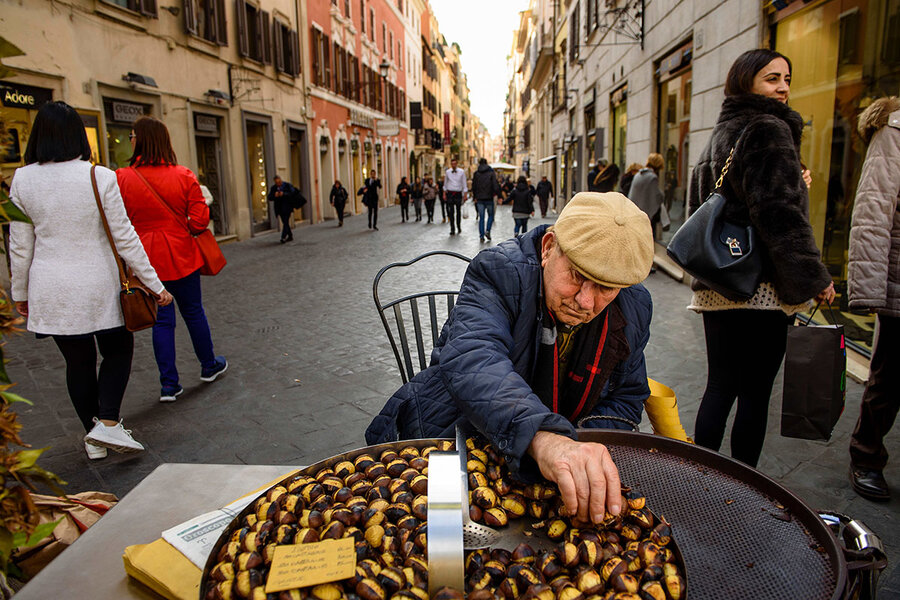How to roast your own chestnuts this winter
Loading...
I’ve always loved chestnuts. A venerable chestnut tree grew a few blocks from my childhood home in upstate New York, and I avidly collected them from the adjacent city sidewalk. In retrospect I realize my booty wasn’t true, American chestnuts, whose fruit can be roasted and eaten, but horse chestnuts, or buckeyes, bitter and inedible. No matter. I simply enjoyed the nuts’ gleaming two-tone brown shells and their silky feel in my palms and pockets, where I’d juggle them like loose change.
I’d empty my bag into a desk drawer, and admire them from time to time. Confronted with a difficult homework assignment, I’d pick one out to finger and polish with my palm. It helped me focus.
Years later, a suitor stopped me on a walk and slipped a fallen buckeye into my hand without a word. If we never became a couple, recalling the gesture still brings a smile. He had no idea he’d planted the perfect seed of friendship.
It was only much later that I learned to eat true chestnuts of the European variety, finding them sweet and delicious. I was in Zurich, visiting family one winter, when I discovered them for sale from street-side roasting stands redolent with steam.
It was love at first taste.
Swiss winters in my current home near Basel bring one word to mind, and it’s not “snow” or “skiing.” It’s marroni (chestnuts), served up hot and split by the bagful on the coldest days. Street vendors lean ruddy-faced over big iron pots fired by charcoal, with ready-to-eat nuts in a pan on top. For a few francs I can buy a bag and shift it from pocket to pocket to quickly warm my hands. I slowly pull back husk after husk to savor the soft, sweet, chewy nuts within.
This being Switzerland, each bag of chestnuts comes with a smaller bag attached for the shells, which otherwise might litter the streets. Still, I always toss a couple of chestnuts into some greenery for birds and small wildlife.
Hot-chestnut stands dot the streets well past Christmas, and it’s the one downside to spring to see them disappear. I’d relish a bag anytime of year.
Ah, but in winter! Thin on protein and fat, chestnuts deliver starch in abundance. Hot chestnuts sustain and uplift. An inexpensive staple for centuries, chestnut flour was widely used in bread-making. It is said that both Alexander the Great and the Romans planted chestnut trees across Europe in the course of their empire-building.
But to me, chestnuts are simply winter treats. They are meaty and satisfying. They warm my innards as well as my hands, and are well worth a tram ride into the city for those purposes alone. Nutrition is a side benefit. It makes me happy just to find one on the ground, and much more so to pop one in my mouth from a steaming paper bag. Plus, there is the feeling of virtue in dropping the husk bag in an Abfall container and the satisfaction of tossing out the last few portions to share with foragers.
Not a bad return from a plain little brown nut on a cold winter day.
Roasted chestnuts recipe
Look for chestnuts in the produce section of your grocery store. Don’t be tempted by horse chestnuts, or buckeyes, that may grow locally. They are bitter and toxic.
1. Rinse and dry chestnuts.
2. Using a sharp knife, carefully cut an X through the rounded top outer husk of each nut. This makes them easier to peel – and keeps them from exploding in your oven.
3. Soak chestnuts in water for an hour. Drain.
4. Preheat oven to 425 degrees Fahrenheit.
5. Put chestnuts in a single layer in a pan and roast for 20 minutes or so. When the husks start peeling back, they are done.
6. Remove from oven. Put hot nuts in a clean towel and wrap them up tightly to steam for 15 minutes, or put them in a paper bag and close it tightly. Peel and eat!





